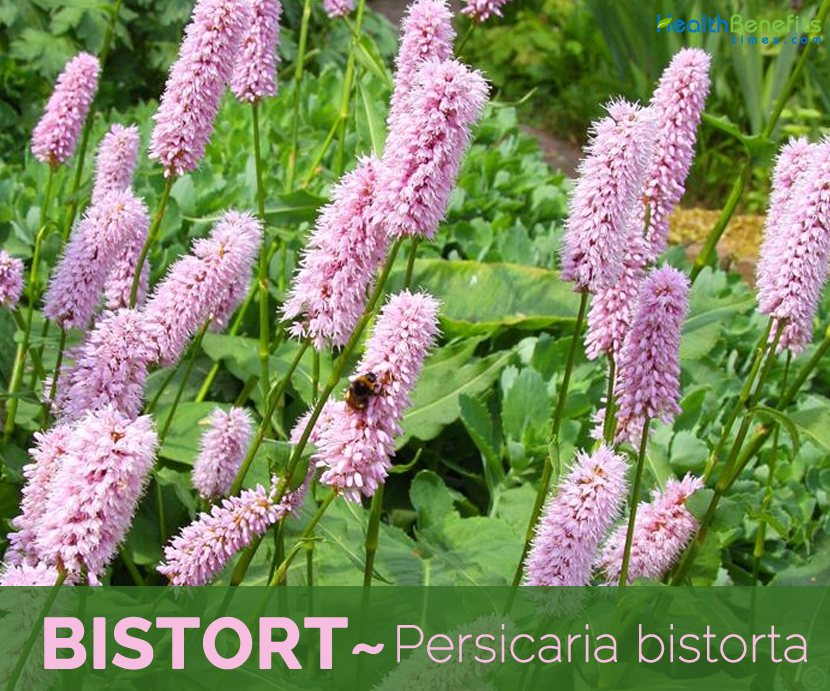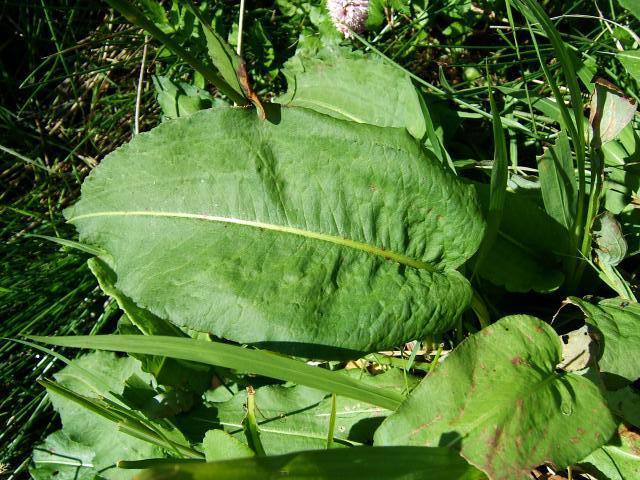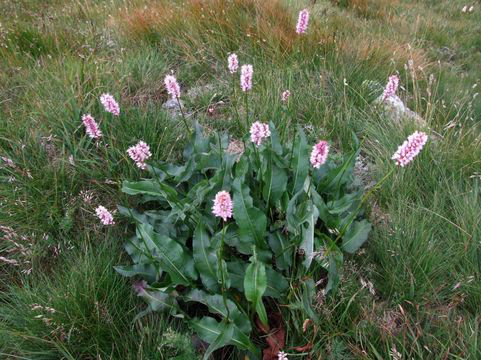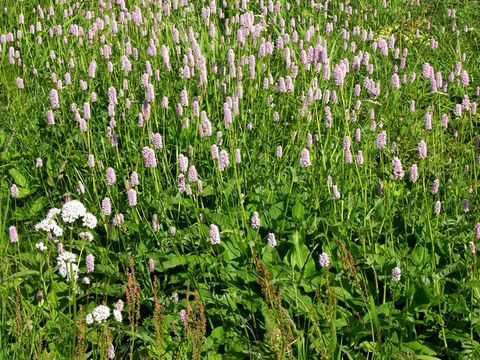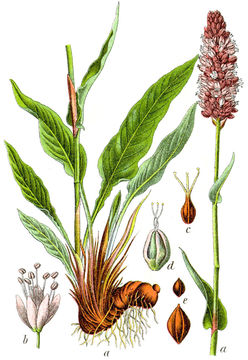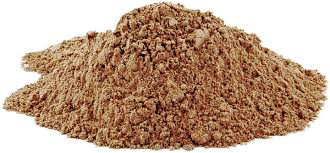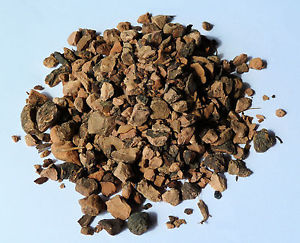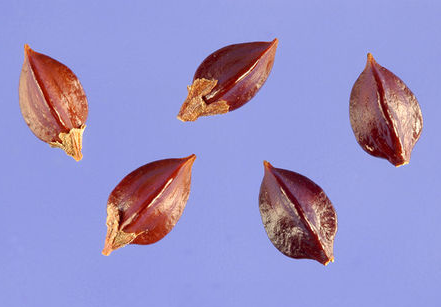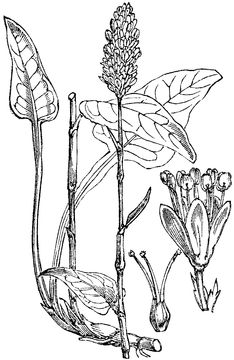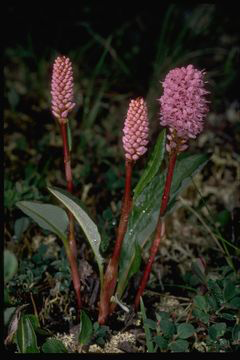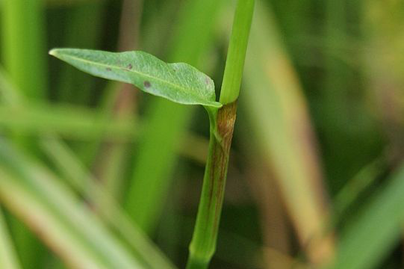Plant Description
Bistort is an herbaceous, perennial, flowering plant that grows about 75 cm (30 in) tall by 90 cm (35 in) wide. The plant is typically found growing in moist meadows, nutrient-rich wooded swamps, forest edges, wetlands, parks, gardens and disturbed ground, field, hilly grasslands and meadows. It is best grown in organically rich, consistently moist, moisture-retentive soils rich in silicic acid. The plant has fleshy and cylindrical, thick, twisted rootstock. It has a brownish-black color on the outside, while internally its color is red. Stem is simple and erect, cylindrical, knotted at the joints, striated, smooth unbranched and hairless.
Leaves
The leaves which spring directly from the upper side of the root system are oval with heart shaped bases of a bluish green cooler, on the upper sides and ash grey, often tinged with purple beneath. Both the leaf stalks and the leaf blades are about six inches (15 cm) long. The upper part of the leaf stalk is winged. Those of the stem are all smaller, clasping and almost stalk less, each as long membranous stipule.
Flower
The flowers are arranged in a terminal, dense, cylindrical spike. Each tiny individual flower is supported on a very short stalk, with shining, serrate membranous bractea (very small bracts) at the base. Each flesh-pinkish flower consists of five colored sepals, eight stamens and an ovary of two or three styles. Flowers are grouped in two’s, one flower complete, the other with normal stamens but only a rudimentary ovary. The styles of this complete flower do not mature and become receptive of pollen from visiting insects, till their stamens have shed their pollen and fallen, hence cross-fertilization is ensured. Flowering normally takes place from June and July.
Fruit
The fruit (seed capsule) is a triangular pointed nut containing a single seed and surrounded by a persistent calyx. Birds often feed on the seeds, which were once utilized to feed and fatten poultry.
Traditional uses and benefits of Bistort
- It has also been used traditionally for medicinal purposes. Roots are rich in tannic and gallic acids and both these and the leaves have been used to treat wounds.
- Root of Bistort can be used to produce an astringent that was used in medicine.
- It is useful to cure bleeding disorders whether internal or external.
- It is helpful to prevent hemorrhages from the lungs and stomach.
- It helps to alleviate nose bleeds and nasal polyps.
- It is used for the treatment of fever.
- It is good herbal cure for Purelent Otorrhea.
- An infusion of its plant is used as a mouthwash to treat oral problems like bleeding gums, mouth ulcers, swollen gums, stomatitis, sore throat and looseness of teeth.
- Gargle with bistort is effective in curing these mouth problems.
- It is potent for curbing liver ailments like jaundice.
- It is helpful in curing dysentery and diarrhea.
- It is effective in killing intestinal worms.
- It is beneficial in treating bowel complaints and cholera.
- It is a good herbal treatment for urinary incontinence.
- Decoction prepared from bistort is significant for alleviating menstruating pain and leucorrhea in women.
- It is a good herbal remedy for skin infection, skin eruptions, measles, and burns.
- It arrests bleeding in wounds and cuts.
- Make a lotion of the herb to get fast relief and apply to the skin for treating ulcers.
- It is effective in curbing diabetes.
- Herb has also been used to treat dysentery, cholera, gastritis, cystitis and heavy menstrual bleeding.
- External uses include the treatment of inflamed mucous membranes and skin disorders, burns, sore nipples, gingivitis, bleeding gums, inflammation of the pharynx (pharyngitis), vaginal discharge, hemorrhoids and anal fissures.
- To treat diarrhea it may be used with other astringent herbs such as agrimony (Agrimonia eupatoria), spotted geranium (Geranium maculatum) or English oak (Quercus robur).
- It was traditionally used to treat infectious diseases, to stop bleeding and to treat snake bites.
- Herb may be useful as an herbal remedy for ulcers, gastritis, enteritis and irritable bowel syndrome.
- Bistort is also used to treat urinary tract disorders such as cystitis and incontinence.
- Traditionally, boiling the roots made a wine, which was then used for curing dysentery and diarrhea, impeding vomiting, controlling excessive menstruation, and curing inflammation of the mouth and throat.
- Herb is also used in the form of an effective gargle and mouthwash to cure spongy gums, sore throats and canker sores.
- Powder obtained by pulverizing the dried out herb may be applied directly to any wound to stop bleeding.
- Bistort may also be used in the form of a douche for healing erosion and inflammation of the vagina and cervix.
- Being a potent astringent, bistort is very helpful in treating bedwetting.
Bistort Tea Benefits
Bistort tea benefits believed to be imparted by this brew:
- Bistort tea may help in the treatment of diarrhea, dysentery and irritable bowel syndrome.
- Bistort tea may aid in the treatment of diverticulitis.
- Bistort tea may help in the treatment of oral and tongue inflammations. It may also help fight pharyngitis and sore throat.
- Bistort tea may help in the treatment of jaundice.
- Bistort tea may aid in fighting measles and smallpox.
- Bistort tea may help in fighting hemorrhoids.
- Bistort tea may help ease menstrual bleeding.
- Bistort tea, applied topically, may help in the healing of wounds, skin ruptures and burstings.
- Bistort tea may help expel worms.
Ayurvedic Health benefits of Bistort
- External Bleeding: Make a paste of the leaves. Apply as a poultice to the bleeding Part.
- Gum disease: Put 2 tbsp rootstock in a cup of water and boil for 8-10 minutes. Use it as a mouthwash for gum problems and inflammations of the mouth.
- Wounds: Take 2 tbsp rootstock of bistort and a cup of water. Boil them together for 10 minutes. Use as a wash for wounds and external ulcers. OR Use the rootstock to make a poultice for wounds.
- Sore Throat: Use one tbsp bistort rootstock with half cup of water. Boil for 5-7 minutes. Take a mouthful at a time, half cup a day. OR Use it lukewarm as a gargle.
- Small Pox: Prepare a decoction of the leaves of Bistort. Sponge the whole body with this water.
Culinary Uses
- Plant was used to make a bitter pudding in Lent from a combination of the plant’s leaves, oatmeal, egg and other herbs in Northern England.
- It is the principal ingredient of dock pudding or Easter-Ledge Pudding.
- Young leaves can be used in salads or cooked and prepared like spinach.
- Rhizome is known to have high starch content and is said to be very tasty and nutritious.
- Reddish colored roots may be treated like potatoes and used in soups, stews or roasted.
- Roots may be dried into a powder and used to make bread flour.
- Bistort may also be used to make a tea for use as a general tonic and health benefits.
- Roots of bistort are edible raw or after being roasted over fire. The flavor of roasted bistort root reminds one of chestnuts.
- Dry seeds of bistort are also roasted and consumed in the form of cracked grain.
Dosage and Administration
A gargle, to treat infection in the mouth and throat, can be made by using one or two grams of the dried rhizomes to one cup of warm water. It should then stand and brew for five hours.
Medicinally, bistort is used in the form of decoction and tincture.
Decoction: To prepare a decoction from bistort add one teaspoonful of the dried out herb to one cup (250 ml) of water and boil the mixture. Seethe it for about 10 to 15 minutes and then strain the liquid. For best results, this decoction should be drunk thrice every day. It can also be used externally in the form of a gargle or mouthwash.
Tincture: The tincture prepared from bistort needs to be taken in dosage of 2 ml to 4 ml thrice every day.
Other facts
- Bistort has been cultivated both as an ornamental plant and as a vegetable, its roots, leaves and young shoots being steamed or boiled.
- Root is a useful source of food in times of famine.
- Herb is also useful in treating ailments in children and is safe for use when used in correct dosage amounts.
Precautions
- Excess use may cause Nausea, stomach disorders and liver disorders.
- Large dosages of the herb may cause irritation of the digestive tract, constipation, nausea and vomiting.
- Take medications at least one hour prior to consuming bistort.
- Consuming many bistorts may aggravate rheumatism, gout, arthritis and kidney stones.
- It is essential for pregnant women to consult their physician prior to using bistort.
References:
https://www.itis.gov/servlet/SingleRpt/SingleRpt?search_topic=TSN&search_value=823770#null
http://www.theplantlist.org/tpl1.1/record/kew-2571994
https://www.botanical.com/botanical/mgmh/b/bistor45.html
https://en.wikipedia.org/wiki/Persicaria_bistorta
https://plants.usda.gov/core/profile?symbol=pobi5
Comments
| Bistort Quick Facts | |
|---|---|
| Name: | Bistort |
| Scientific Name: | Persicaria bistorta |
| Origin | Europe and north and west Asia |
| Colors | Black |
| Shapes | Triangular pointed glossy nut containing a single seed and surrounded by a persistent calyx |
| Taste | Bitter, Astringent (Root) Sour (Leaves) |
| Health benefits | Treat oral problems, jaundice, dysentery and diarrhea & diabetes |
| Name | Bistort |
|---|---|
| Scientific Name | Persicaria bistorta |
| Native | Europe and north and west Asia |
| Common Names | Bistort, European bistort, snakeroot, snake-root, snakeweed and Easter-ledges, Common bistort, snakeweed, poor man’s cabbage, oderwort, meadow bistort, adderwort, osterick, pink pokers, English serpentary, dragonwort, Easter mangiants, Easter giants, easterman giants, pudding grass, passion dock, sweet dock, patience dock, Passions, Red Legs, Sweet Dock |
| Name in Other Languages | Arabic: Angubâr, Anârif Chinese : Quan can (拳参), Quan liao (拳蓼), Zi can Danish: Slangeurt, Almindeling slangeurt Dutch: Adderwortel English: Common bistort, Snake weed, Snake root, Adder-wort, meadow bistort Estonian: Ussitatar Finnish: Konnantatar, Isokonnantatar French: Renouée bistorte, Serpentaire, Serpentaire rouge, Bistorte, Feuillotte, Andrelles, Bistorte officinale, Langue de Bœuf German: Schlangen-Knöterich, Schlangenknöterich, Matterknöterich, Wiesenknöterich Hindi: Amli, Kutrya Icelandic: Slöngusúra Italian: Poligono bistorta, Poligono ritorto, Bistorta Polish: Rdest wężownik Russian: Gorec zmejnyj, горец змейный Swedish: Stor ormrot Turkish: Ancubar, Kurd pençesi, Çiançik |
| Plant Growth Habit | Herbaceous, perennial, flowering plant |
| Growing Climate | Typically found growing in moist meadows, nutrient-rich wooded swamps, forest edges, wetlands, parks, gardens and disturbed ground, field, hilly grasslands, meadows |
| Soil | Best grown in organically rich, consistently moist, moisture-retentive soils rich in silicic acid |
| Plant Size | 75 cm (30 in) tall by 90 cm (35 in) wide |
| Root | Fleshy and cylindrical, thick, twisted rootstock. It has a brownish-black color on the outside, while internally its color is red. |
| Stem | Simple and erect, cylindrical, knotted at the joints, striated, smooth unbranched and hairless |
| Leaf | Lanceolate, oblong-ovate or triangular-ovate in shape. They are bluish green, longer near the base, and becoming smaller higher up the stem. |
| Flowering Periods | June and July |
| Flower | Flowers are pink with five perianth segments, eight stamens, three fused carpels and three free styles |
| Fruit Shape & Size | Seed capsule is a triangular pointed glossy nut containing a single seed and surrounded by a persistent calyx |
| Fruit Color | Black |
| Taste | Bitter, Astringent (Root) Sour (Leaves) |
| Seed | Shiny, dark brown and triangular |
| Plant Parts Used | Root, rhizome, Leaves |
| Available Forms | Decoction, tincture or a powder |


